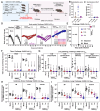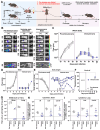Beta Spike-Presenting SARS-CoV-2 Virus-like Particle Vaccine Confers Broad Protection against Other VOCs in Mice
- PMID: 39340037
- PMCID: PMC11435481
- DOI: 10.3390/vaccines12091007
Beta Spike-Presenting SARS-CoV-2 Virus-like Particle Vaccine Confers Broad Protection against Other VOCs in Mice
Abstract
Virus-like particles (VLPs) are non-infectious and serve as promising vaccine platforms because they mimic the membrane-embedded conformations of fusion glycoproteins on native viruses. Here, we employed SARS-CoV-2 VLPs (SMEN) presenting ancestral, Beta, or Omicron spikes to identify the variant spike that elicits potent and cross-protective immune responses in the highly sensitive K18-hACE2 challenge mouse model. A combined intranasal and intramuscular SMEN vaccine regimen generated the most effective immune responses to significantly reduce disease burden. Protection was primarily mediated by antibodies, with minor but distinct contributions from T cells in reducing virus spread and inflammation. Immunization with SMEN carrying ancestral spike resulted in 100, 75, or 0% protection against ancestral, Delta, or Beta variant-induced mortality, respectively. However, SMEN with an Omicron spike provided only limited protection against ancestral (50%), Delta (0%), and Beta (25%) challenges. By contrast, SMEN with Beta spikes offered 100% protection against the variants used in this study. Thus, the Beta variant not only overcame the immunity produced by other variants, but the Beta spike also elicited diverse and effective humoral immune responses. Our findings suggest that leveraging the Beta variant spike protein can enhance SARS-CoV-2 immunity, potentially leading to a more comprehensive vaccine against emerging variants.
Keywords: Beta; Omicron; SARS-CoV-2; cross-VOC protection; intramuscular; intranasal; neutralizing antibodies; vaccine; variants of concern; virus-like particles.
Conflict of interest statement
The authors declare no conflicts of interest. The funders had no role in the design of the study; in the collection, analyses, or interpretation of data; in the writing of the manuscript; or in the decision to publish the results.
Figures






Similar articles
-
A Beta Strain-Based Spike Glycoprotein Vaccine Candidate Induces Broad Neutralization and Protection against SARS-CoV-2 Variants of Concern.Microbiol Spectr. 2023 Feb 27;11(2):e0268722. doi: 10.1128/spectrum.02687-22. Online ahead of print. Microbiol Spectr. 2023. PMID: 36847495 Free PMC article.
-
Ipsilateral or contralateral boosting of mice with mRNA vaccines confers equivalent immunity and protection against a SARS-CoV-2 Omicron strain.J Virol. 2024 Sep 17;98(9):e0057424. doi: 10.1128/jvi.00574-24. Epub 2024 Aug 28. J Virol. 2024. PMID: 39194250 Free PMC article.
-
SARS-CoV2 variant-specific replicating RNA vaccines protect from disease following challenge with heterologous variants of concern.Elife. 2022 Feb 22;11:e75537. doi: 10.7554/eLife.75537. Elife. 2022. PMID: 35191378 Free PMC article.
-
Beta-containing bivalent SARS-CoV-2 protein vaccine elicits durable broad neutralization in macaques and protection in hamsters.Commun Med (Lond). 2023 May 26;3(1):75. doi: 10.1038/s43856-023-00302-z. Commun Med (Lond). 2023. PMID: 37237062 Free PMC article.
-
The Biological Functions and Clinical Significance of SARS-CoV-2 Variants of Corcern.Front Med (Lausanne). 2022 May 20;9:849217. doi: 10.3389/fmed.2022.849217. eCollection 2022. Front Med (Lausanne). 2022. PMID: 35669924 Free PMC article. Review.
Cited by
-
Simian Immunodeficiency Virus-Based Virus-like Particles Are an Efficient Tool to Induce Persistent Anti-SARS-CoV-2 Spike Neutralizing Antibodies and Specific T Cells in Mice.Vaccines (Basel). 2025 Feb 21;13(3):216. doi: 10.3390/vaccines13030216. Vaccines (Basel). 2025. PMID: 40266067 Free PMC article.
References
Grants and funding
LinkOut - more resources
Full Text Sources
Miscellaneous

